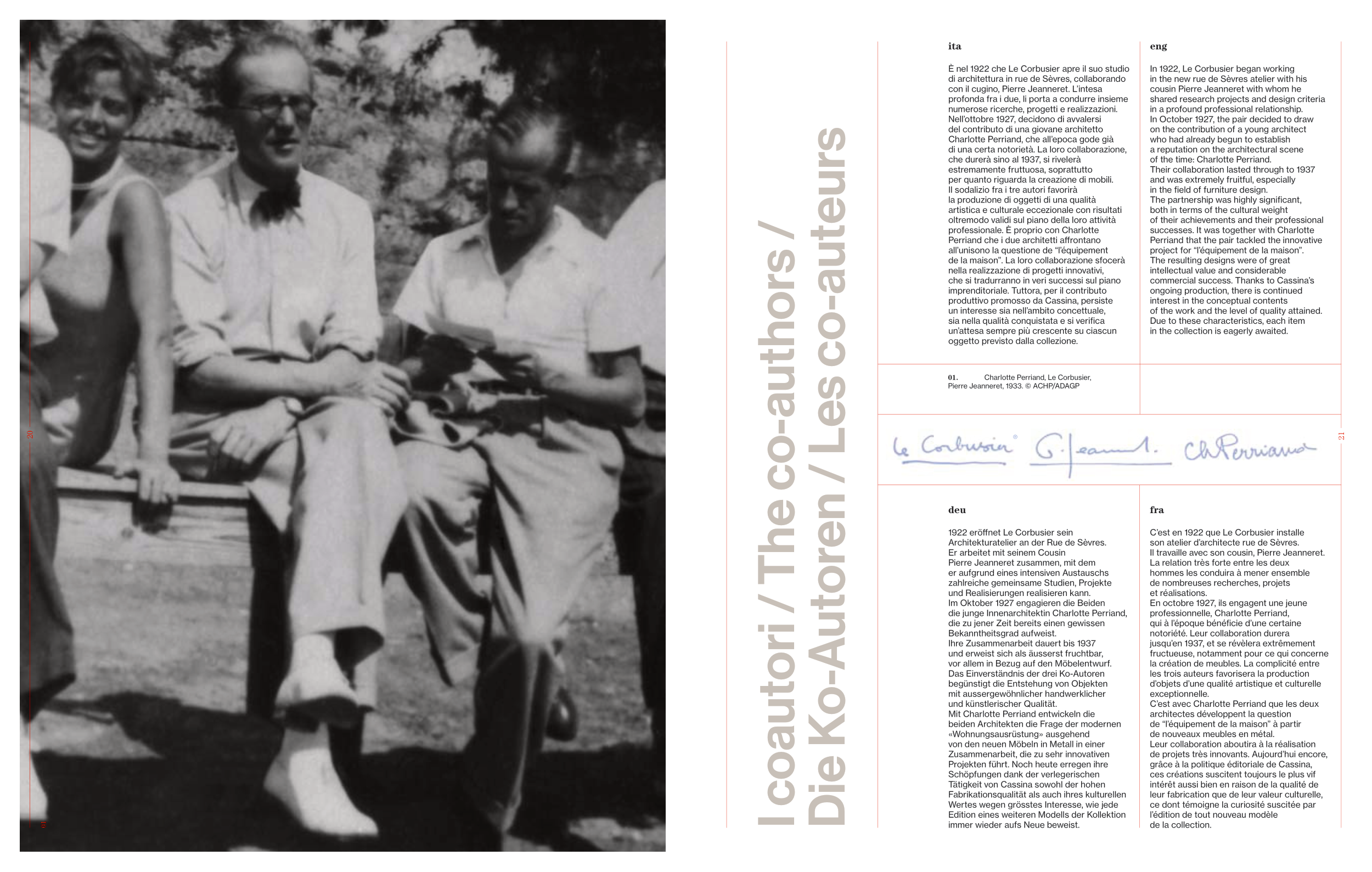I coautori / The co-authors /
Die Ko-Autoren / Les co-auteurs
È nel 1922 che Le Corbusier apre il suo studio
di architettura in rue de Sèvres, collaborando
con il cugino, Pierre Jeanneret. L’intesa
profonda fra i due, li porta a condurre insieme
numerose ricerche, progetti e realizzazioni.
Nell’ottobre 1927, decidono di avvalersi
del contributo di una giovane architetto
Charlotte Perriand, che all’epoca gode già
di una certa notorietà. La loro collaborazione,
che durerà sino al 1937, si rivelerà
estremamente fruttuosa, soprattutto
per quanto riguarda la creazione di mobili.
Il sodalizio fra i tre autori favorirà
la produzione di oggetti di una qualità
artistica e culturale eccezionale con risultati
oltremodo validi sul piano della loro attività
professionale. È proprio con Charlotte
Perriand che i due architetti aff rontano
all’unisono la questione de “l’équipement
de la maison”. La loro collaborazione sfocerà
nella realizzazione di progetti innovativi,
che si tradurranno in veri successi sul piano
imprenditoriale. Tuttora, per il contributo
produttivo promosso da Cassina, persiste
un interesse sia nell’ambito concettuale,
sia nella qualità conquistata e si verifi ca
un’attesa sempre più crescente su ciascun
oggetto previsto dalla collezione.
C’est en 1922 que Le Corbusier installe
son atelier d’architecte rue de Sèvres.
Il travaille avec son cousin, Pierre Jeanneret.
La relation très forte entre les deux
hommes les conduira à mener ensemble
de nombreuses recherches, projets
et réalisations.
En octobre 1927, ils engagent une jeune
professionnelle, Charlotte Perriand,
qui à l’époque bénéfi cie d’une certaine
notoriété. Leur collaboration durera
jusqu’en 1937, et se révèlera extrêmement
fructueuse, notamment pour ce qui concerne
la création de meubles. La complicité entre
les trois auteurs favorisera la production
d’objets d’une qualité artistique et culturelle
exceptionnelle.
C’est avec Charlotte Perriand que les deux
architectes développent la question
de “l’équipement de la maison” à partir
de nouveaux meubles en métal.
Leur collaboration aboutira à la réalisation
de projets très innovants. Aujourd’hui encore,
grâce à la politique éditoriale de Cassina,
ces créations suscitent toujours le plus vif
intérêt aussi bien en raison de la qualité de
leur fabrication que de leur valeur culturelle,
ce dont témoigne la curiosité suscitée par
l’édition de tout nouveau modèle
de la collection.
1922 eröff net Le Corbusier sein
Architekturatelier an der Rue de Sèvres.
Er arbeitet mit seinem Cousin
Pierre Jeanneret zusammen, mit dem
er aufgrund eines intensiven Austauschs
zahlreiche gemeinsame Studien, Projekte
und Realisierungen realisieren kann.
Im Oktober 1927 engagieren die Beiden
die junge Innenarchitektin Charlotte Perriand,
die zu jener Zeit bereits einen gewissen
Bekanntheitsgrad aufweist.
Ihre Zusammenarbeit dauert bis 1937
und erweist sich als äusserst fruchtbar,
vor allem in Bezug auf den Möbelentwurf.
Das Einverständnis der drei Ko-Autoren
begünstigt die Entstehung von Objekten
mit aussergewöhnlicher handwerklicher
und künstlerischer Qualität.
Mit Charlotte Perriand entwickeln die
beiden Architekten die Frage der modernen
«Wohnungsausrüstung» ausgehend
von den neuen Möbeln in Metall in einer
Zusammenarbeit, die zu sehr innovativen
Projekten führt. Noch heute erregen ihre
Schöpfungen dank der verlegerischen
Tätigkeit von Cassina sowohl der hohen
Fabrikationsqualität als auch ihres kulturellen
Wertes wegen grösstes Interesse, wie jede
Edition eines weiteren Modells der Kollektion
immer wieder aufs Neue beweist.
In 1922, Le Corbusier began working
in the new rue de Sèvres atelier with his
cousin Pierre Jeanneret with whom he
shared research projects and design criteria
in a profound professional relationship.
In October 1927, the pair decided to draw
on the contribution of a young architect
who had already begun to establish
a reputation on the architectural scene
of the time: Charlotte Perriand.
Their collaboration lasted through to 1937
and was extremely fruitful, especially
in the fi eld of furniture design.
The partnership was highly signifi cant,
both in terms of the cultural weight
of their achievements and their professional
successes. It was together with Charlotte
Perriand that the pair tackled the innovative
project for “l’équipement de la maison”.
The resulting designs were of great
intellectual value and considerable
commercial success. Thanks to Cassina’s
ongoing production, there is continued
interest in the conceptual contents
of the work and the level of quality attained.
Due to these characteristics, each item
in the collection is eagerly awaited.
ita
fra
deu
eng
01.
Charlotte Perriand, Le Corbusier,
Pierre Jeanneret, 1933. © ACHP/ADAGP
01
21
20


